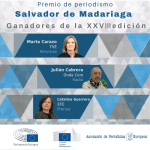The European Commission and Europa Nostra have just announced the 2022 winners of the European Heritage Awards / Europa Nostra Awards, funded by the EU Creative Europe programme. This year, which marks the 20th anniversary of Europe’s most prestigious Awards in the heritage field, 30 outstanding heritage achievements from 18 European countries have been awarded in five categories. These categories are in line with the latest developments and priorities related to heritage policy and practice in Europe.
The winners will be celebrated on 26 September in Prague at the European Heritage Awards Ceremony, to be held at the recently restored State Opera and co-hosted by the European Commissioner for Innovation, Research, Culture, Education and Youth, Mariya Gabriel, and Europa Nostra’s Executive President, Prof. Dr. Hermann Parzinger.
Reacting to the announcement of the 2022 winners, the European Commissioner Mariya Gabriel, stated: “I warmly congratulate all the winners of this year’s European Heritage Awards / Europa Nostra Awards for the exceptional quality of their work and their openness to innovation. 2022 is a special year as we are celebrating the 20th anniversary of the EU Prize for Cultural Heritage, which has become the most prominent award for the European heritage community. Many of the awarded initiatives demonstrate the enormous interest and engagement of young people for our heritage, our history, and our cultural identity, which is particularly relevant in this European Year of Youth. A special thought goes to the two Ukrainian laureates. Creative Europe, which is co-funding the Awards, stands for promoting culture and creativity in building inclusive and cohesive societies founded on our core European values.”
Europa Nostra’s Executive President, Prof. Dr. Hermann Parzinger, said: “This year’s Award winners are powerful examples of how our heritage reconnects us with nature, helps create a sense of belonging and place, and is an integral building block in developing a circular economy that supports a sustainable and inclusive way of life. I congratulate these exceptional winners – professionals and enthusiasts alike – for their essential and commendable work”.
2022 Winners of the European Heritage Awards / Europa Nostra Awards
Conservation and Adaptive Reuse
Aachen Battery, Atlantikwall Raversyde, West-Flanders, BELGIUM
Aachen is the only German WWI coastal battery of which enough remains for visitors to grasp its structure. This gives the restoration and regeneration of the site great European significance and pedagogical value.
Villa E-1027, Roquebrune-Cap-Martin, FRANCE
Villa E-1027 was designed in the 1920s by the Irish architect and furniture designer Eileen Gray with the Romanian architect Jean Badovici. Its complete restoration, down to all interior objects and materials, including advanced systems to avoid corrosion, is exemplary for the future preservation of Modernist Architecture.
Monument of Episkopi, Sikinos, GREECE
This impressive Roman mausoleum was converted to a Byzantine church, meaning it has survived nearly intact. Meticulous research was combined with cautious conservation, resulting in a high-quality restoration project.
Atlungstad Distillery, Ottestad, NORWAY
Established in 1855, this is the oldest Norwegian distillery still in use. Its rehabilitation included the reuse of the old factory machinery, restoring the building’s industrial character and giving it new socio-cultural purposes.
Convent of the Capuchos, Sintra, PORTUGAL
Built in 1560, this monastic complex in the native forest of Sintra breathes spiritual devotion and asceticism. All buildings and their decorative features were restored, combining traditional techniques and innovative solutions.
House of Religious Freedom, Cluj-Napoca, ROMANIA
This 15th-century building is one of the oldest and most significant in Cluj-Napoca. After a decade-long restoration process, the townhouse was reopened as a cultural centre dedicated to the ideals of religious freedom and tolerance.
Illa del Rei, Menorca, SPAIN
The rehabilitation of Illa del Rei is the result of a fruitful collaboration between a foundation established by local volunteers, who turned the naval hospital built in 1711 into a museum, and a Swiss art gallery, which restored and sensitively repurposed the Langara outbuildings.
St. Andrew’s Church, Kyiv, UKRAINE
This comprehensive and well documented restoration has returned a monument with significant cultural and spiritual value to the people of Ukraine. The church now functions as a museum and hosts church services, scientific and educational events and chamber music concerts.

New pan-European partnership on Culture and Creativity
|
Research
Heritage Opportunities/threats within Mega-Events in Europe (HOMEE), CYPRUS / ITALY / POLAND / UNITED KINGDOM
This project investigated the opportunities and challenges of organising mega-events in heritage cities and established an important quality framework for future events.
SILKNOW, FRANCE / GERMANY / ITALY / POLAND / SLOVENIA / SPAIN
This Horizon 2020 project produced a comprehensive intelligent computational system that goes beyond current technologies to improve our understanding and knowledge of Europe’s silk heritage.
Heritage Quest, THE NETHERLANDS
This large-scale citizen science project in the field of archaeology has uncovered new archaeological objects and combined state-of-the-art technologies with the building of community.
Safeguarding of Sicilian Puppet Theatre, ITALY
This project proposes measures to safeguard, promote and sustainably manage the intangible heritage of Sicilian Puppet Theatre.
Education, Training and Skills
Masters and Apprentices, FINLAND
Younger and older generations are brought together on equal terms in this project, to collaborate on shared activities around cultural heritage – an exciting new model for the transmission of intangible heritage.
International Course on Wood Conservation Technology, NORWAY
The cross-disciplinary approach to this course allows professionals from different backgrounds and countries to further their education and expertise within the field of wooden heritage.
TISH Jewish Food Festival, Warsaw, POLAND
Through this celebration of Jewish food heritage, participants talk about their shared history, combat stereotypes and break down barriers through a series of culinary workshops and food tastings.
Piscu School Museum and Workshop, ROMANIA
Cultural heritage, contemporary art and ceramics come together to generate a cultural and educational hub in a former pottery factory. Summer schools, workshops and cultural events help transmit this fascinating heritage.
Sewn Signs, ROMANIA
This project helps pass on the skills and knowledge around the traditional Romanian shirt and makes a strong statement against the “fast fashion” industry.
Symphony, SPAIN
With an immersive audiovisual experience, Symphony raises greater awareness and appreciation for the heritage of classical music among new generations.
Citizens’ Engagement and Awareness-raising
Rivers of Sofia, BULGARIA
By means of pop-up architectural interventions and cultural and educational events, this initiative made the artificial river beds of Sofia publicly accessible spaces – for the first time in 80 years – and increased their visibility.
Return to the Sámi Homeland, FINLAND
A thoughtful programme of public dialogue preceded the return of an important collection of Sámi cultural heritage from the National Museum of Finland to the Sámi Museum Siida and represents a very important example of the effective restitution of heritage.
Swapmuseum, Apulia, ITALY
Swapmuseum enables collaborations between museums and young people in the museums’ daily practice to help refresh and enrich small, local cultural institutions.
Va’ Sentiero, ITALY
A three-year grassroots expedition by a group of young enthusiasts who walked and documented the 8000 km of Sentiero Italia, the longest hiking route in the world. 3000 participants from 10 countries and many local communities took part.
“Lumbardhi Public Again” Project, Prizren, KOSOVO
Lumbardhi Public Again is a successful initiative to save the historic Lumbardhi Cinema from privatisation and demolition. Their activities have reclaimed the cinema as a heritage site which has become a vibrant centre for cultural activities.
Museum in the Village, PORTUGAL
This cultural programme brings together museums, artists and communities to enjoy art and culture, learn about and revive local folklore and heritage and improve access to cultural activities in rural areas.
PAX-Patios de la Axerquía, Córdoba, SPAIN
This is an innovative system of governance for heritage buildings that fosters a new model of urban regeneration through social innovation in a heritage context, based on the rehabilitation of the abandoned patio-houses (casa de vecinos) of Córdoba.
Wikipedra, SPAIN
Wikipedra utilises citizens’ science to develop a knowledge database that could save the dry-stone heritage of Spain and border regions from oblivion through a website and mobile app.
World Vyshyvanka Day, UKRAINE
What began as a small student mob is now an annual holiday celebrated internationally that helps preserve the iconic Ukrainian embroidered shirt (vyshyvanka) as an important element of the heritage of the Ukrainian people.
Heritage Champions
Costa Carras †, Athens, GREECE (posthumously)
For over 50 years, Costa Carras worked tirelessly in favour of Greece’s and Europe’s cultural and natural heritage to create a more sustainable, inclusive and beautiful world for future generations. He was a visionary conservationist, an eminent historian and a true European.
La Paranza Cooperative, Naples, ITALY
This cooperative of young friends has worked, since the early 2000s, to transform the catacombs of Naples into a vibrant attraction for visitors, also bringing about the tangible revitalisation of the Sanità neighbourhood.
Elżbieta Szumska, Złoty Stok, POLAND
With her tireless dedication, Elżbieta Szumska helped transform the former gold mine of Kopalnia Złota, located in the small town of Złoty Stok, into one of Poland’s most well-known tourist attractions.
In addition, a Europa Nostra Award is presented to a remarkable heritage achievement from a European country not taking part in the EU Creative Europe programme:
Kenan Yavuz Ethnography Museum, Bayburt, TURKEY (Citizens’ Engagement and Awareness-raising)
This museum aims to preserve and revive the tangible and intangible cultural heritage of Bayburt and Anatolia by providing interactive experiences to its visitors, designed in collaboration with the local community.
The Award winners were decided by the Jury composed of heritage experts from across Europe, upon evaluation by the independent Selection Committees of candidatures submitted by organisations and individuals from 36 European countries.







Leave a Reply